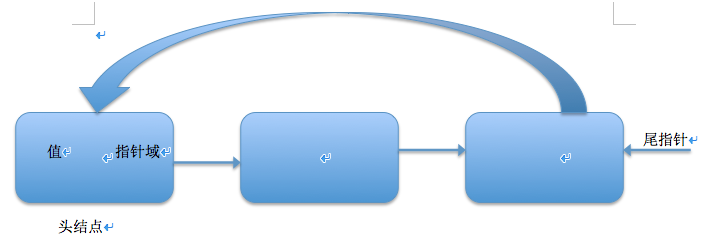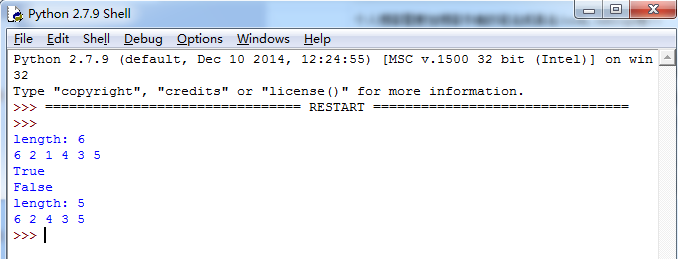Python实现的单向循环链表功能示例
发布于 2018-02-16 01:57:54 | 126 次阅读 | 评论: 0 | 来源: 网友投递
Python编程语言
Python 是一种面向对象、解释型计算机程序设计语言,由Guido van Rossum于1989年底发明,第一个公开发行版发行于1991年。Python语法简洁而清晰,具有丰富和强大的类库。它常被昵称为胶水语言,它能够把用其他语言制作的各种模块(尤其是C/C++)很轻松地联结在一起。
这篇文章主要介绍了Python实现的单向循环链表功能,简单描述了单向循环链表的概念、原理并结合实例形式分析了Python定义与使用单向循环链表的相关操作技巧,需要的朋友可以参考下
本文实例讲述了Python实现的单向循环链表功能。分享给大家供大家参考,具体如下:
概述:
单向循环链表是指在单链表的基础上,表的最后一个元素指向链表头结点,不再是为空。

由图可知,单向循环链表的判断条件不再是表为空了,而变成了是否到表头。
操作
is_empty() 判断链表是否为空
length() 返回链表的长度
travel() 遍历
add(item) 在头部添加一个节点
append(item) 在尾部添加一个节点
insert(pos, item) 在指定位置pos添加节点
remove(item) 删除一个节点
search(item) 查找节点是否存在
具体代码:
class Node(object):
"""节点"""
def __init__(self, item):
self.item = item
self.next = None
class SinCycLinkedlist(object):
"""单向循环链表"""
def __init__(self):
self._head = None
def is_empty(self):
"""判断链表是否为空"""
return self._head == None
def length(self):
"""返回链表的长度"""
# 如果链表为空,返回长度0
if self.is_empty():
return 0
count = 1
cur = self._head
while cur.next != self._head:
count += 1
cur = cur.next
return count
def travel(self):
"""遍历链表"""
if self.is_empty():
return
cur = self._head
print cur.item,
while cur.next != self._head:
cur = cur.next
print cur.item,
print ""
def add(self, item):
"""头部添加节点"""
node = Node(item)
if self.is_empty():
self._head = node
node.next = self._head
else:
#添加的节点指向_head
node.next = self._head
# 移到链表尾部,将尾部节点的next指向node
cur = self._head
while cur.next != self._head:
cur = cur.next
cur.next = node
#_head指向添加node的
self._head = node
def append(self, item):
"""尾部添加节点"""
node = Node(item)
if self.is_empty():
self._head = node
node.next = self._head
else:
# 移到链表尾部
cur = self._head
while cur.next != self._head:
cur = cur.next
# 将尾节点指向node
cur.next = node
# 将node指向头节点_head
node.next = self._head
def insert(self, pos, item):
"""在指定位置添加节点"""
if pos <= 0:
self.add(item)
elif pos > (self.length()-1):
self.append(item)
else:
node = Node(item)
cur = self._head
count = 0
# 移动到指定位置的前一个位置
while count < (pos-1):
count += 1
cur = cur.next
node.next = cur.next
cur.next = node
def remove(self, item):
"""删除一个节点"""
# 若链表为空,则直接返回
if self.is_empty():
return
# 将cur指向头节点
cur = self._head
pre = None
# 若头节点的元素就是要查找的元素item
if cur.item == item:
# 如果链表不止一个节点
if cur.next != self._head:
# 先找到尾节点,将尾节点的next指向第二个节点
while cur.next != self._head:
cur = cur.next
# cur指向了尾节点
cur.next = self._head.next
self._head = self._head.next
else:
# 链表只有一个节点
self._head = None
else:
pre = self._head
# 第一个节点不是要删除的
while cur.next != self._head:
# 找到了要删除的元素
if cur.item == item:
# 删除
pre.next = cur.next
return
else:
pre = cur
cur = cur.next
# cur 指向尾节点
if cur.item == item:
# 尾部删除
pre.next = cur.next
def search(self, item):
"""查找节点是否存在"""
if self.is_empty():
return False
cur = self._head
if cur.item == item:
return True
while cur.next != self._head:
cur = cur.next
if cur.item == item:
return True
return False
if __name__ == "__main__":
ll = SinCycLinkedlist()
ll.add(1)
ll.add(2)
ll.append(3)
ll.insert(2, 4)
ll.insert(4, 5)
ll.insert(0, 6)
print "length:",ll.length()
ll.travel()
print ll.search(3)
print ll.search(7)
ll.remove(1)
print "length:",ll.length()
ll.travel()
运行结果:

希望本文所述对大家Python程序设计有所帮助。
推荐阅读
最新资讯